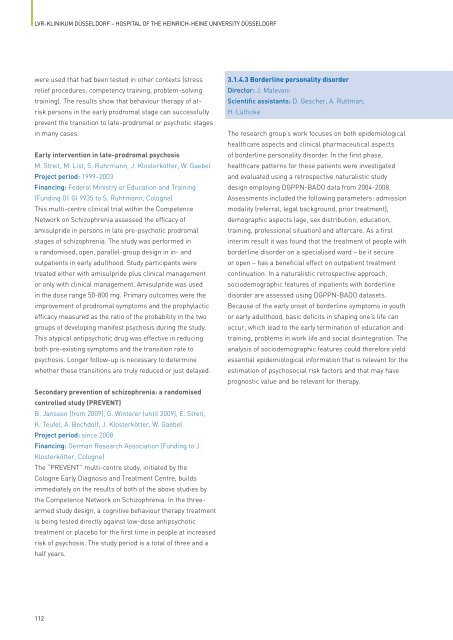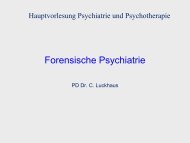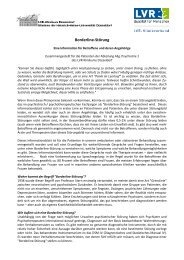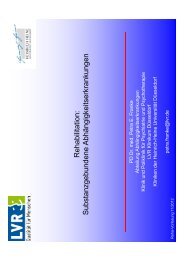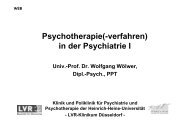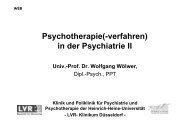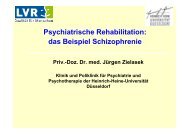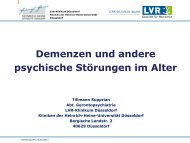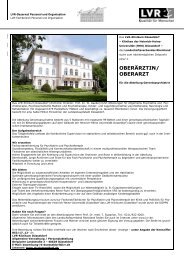LVR-Klinikum Düsseldorf Hospital of the Heinrich-Heine University ...
LVR-Klinikum Düsseldorf Hospital of the Heinrich-Heine University ...
LVR-Klinikum Düsseldorf Hospital of the Heinrich-Heine University ...
Create successful ePaper yourself
Turn your PDF publications into a flip-book with our unique Google optimized e-Paper software.
<strong>LVR</strong>-KLINIKUM DÜsseLDORF – hOsPITaL OF The heINRIch-heINe UNIVeRsITY DÜsseLDORF<br />
were used that had been tested in o<strong>the</strong>r contexts (stress<br />
relief procedures, competency training, problem-solving<br />
training). The results show that behaviour <strong>the</strong>rapy <strong>of</strong> atrisk<br />
persons in <strong>the</strong> early prodromal stage can successfully<br />
prevent <strong>the</strong> transition to late-prodromal or psychotic stages<br />
in many cases.<br />
Early intervention in late-prodromal psychosis<br />
M. Streit, M. List, S. Ruhrmann, J. Klosterkötter, W. Gaebel<br />
Project period: 1999–2003<br />
Financing: Federal Ministry or Education and Training<br />
(Funding 01 GI 9935 to S. Ruhrmann, Cologne)<br />
This multi-centre clinical trial within <strong>the</strong> Competence<br />
Network on Schizophrenia assessed <strong>the</strong> efficacy <strong>of</strong><br />
amisulpride in persons in late pre-psychotic prodromal<br />
stages <strong>of</strong> schizophrenia. The study was performed in<br />
a randomised, open, parallel-group design in in- and<br />
outpatients in early adulthood. Study participants were<br />
treated ei<strong>the</strong>r with amisulpride plus clinical management<br />
or only with clinical management. Amisulpride was used<br />
in <strong>the</strong> dose range 50-800 mg. Primary outcomes were <strong>the</strong><br />
improvement <strong>of</strong> prodromal symptoms and <strong>the</strong> prophylactic<br />
efficacy measured as <strong>the</strong> ratio <strong>of</strong> <strong>the</strong> probability in <strong>the</strong> two<br />
groups <strong>of</strong> developing manifest psychosis during <strong>the</strong> study.<br />
This atypical antipsychotic drug was effective in reducing<br />
both pre-existing symptoms and <strong>the</strong> transition rate to<br />
psychosis. Longer follow-up is necessary to determine<br />
whe<strong>the</strong>r <strong>the</strong>se transitions are truly reduced or just delayed.<br />
Secondary prevention <strong>of</strong> schizophrenia: a randomised<br />
controlled study (PREVENT)<br />
B. Janssen (from 2009), G. Winterer (until 2009), E. Streit,<br />
K. Teufel, A. Bechdolf, J. Klosterkötter, W. Gaebel<br />
Project period: since 2008<br />
Financing: German Research Association (Funding to J.<br />
Klosterkötter, Cologne)<br />
The “PREVENT” multi-centre study, initiated by <strong>the</strong><br />
Cologne Early Diagnosis and Treatment Centre, builds<br />
immediately on <strong>the</strong> results <strong>of</strong> both <strong>of</strong> <strong>the</strong> above studies by<br />
<strong>the</strong> Competence Network on Schizophrenia. In <strong>the</strong> threearmed<br />
study design, a cognitive behaviour <strong>the</strong>rapy treatment<br />
is being tested directly against low-dose antipsychotic<br />
treatment or placebo for <strong>the</strong> first time in people at increased<br />
risk <strong>of</strong> psychosis. The study period is a total <strong>of</strong> three and a<br />
half years.<br />
112<br />
3.1.4.3 Borderline personality disorder<br />
Director: J. Malevani<br />
Scientific assistants: D. Gescher, A. Ruttman,<br />
H. Lüthcke<br />
The research group’s work focuses on both epidemiological<br />
healthcare aspects and clinical pharmaceutical aspects<br />
<strong>of</strong> borderline personality disorder. In <strong>the</strong> first phase,<br />
healthcare patterns for <strong>the</strong>se patients were investigated<br />
and evaluated using a retrospective naturalistic study<br />
design employing DGPPN-BADO data from 2004-2008.<br />
Assessments included <strong>the</strong> following parameters: admission<br />
modality (referral, legal background, prior treatment),<br />
demographic aspects (age, sex distribution, education,<br />
training, pr<strong>of</strong>essional situation) and aftercare. As a first<br />
interim result it was found that <strong>the</strong> treatment <strong>of</strong> people with<br />
borderline disorder on a specialised ward – be it secure<br />
or open – has a beneficial effect on outpatient treatment<br />
continuation. In a naturalistic retrospective approach,<br />
sociodemographic features <strong>of</strong> inpatients with borderline<br />
disorder are assessed using DGPPN-BADO datasets.<br />
Because <strong>of</strong> <strong>the</strong> early onset <strong>of</strong> borderline symptoms in youth<br />
or early adulthood, basic deficits in shaping one’s life can<br />
occur, which lead to <strong>the</strong> early termination <strong>of</strong> education and<br />
training, problems in work life and social disintegration. The<br />
analysis <strong>of</strong> sociodemographic features could <strong>the</strong>refore yield<br />
essential epidemiological information that is relevant for <strong>the</strong><br />
estimation <strong>of</strong> psychosocial risk factors and that may have<br />
prognostic value and be relevant for <strong>the</strong>rapy.


